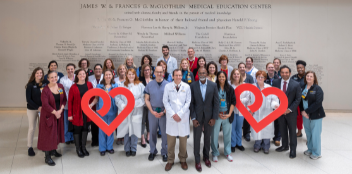A novel approach to treating arrhythmias
High-dose targeted radiation therapy provides ‘great outcome’ to patient with end-stage ventricular tachycardia

When conventional treatment options failed and Reeves’ condition was end stage, VCU Health Pauley Heart Center physicians, in collaboration with colleagues from the Department of Radiation Oncology and Radiology, used a high-dose of targeted radiation therapy to successfully ablate, or destroy, parts of his heart that were believed to be the source of the arrhythmias. In April 2021, Reeves became the first VCU Health patient to undergo radiation therapy for ablation of refractory VT — a new technique still rarely performed nationally. Since treatment, Reeves has had no full or partial VT events, and his high doses of antiarrhythmic medications are being tapered and discontinued.
“We had a great outcome. He’s an impressive success,” said Kenneth Ellenbogen, M.D., director of clinical cardiac electrophysiology and pacing at VCU Medical Center.
A major advantage of the procedure is that it is outpatient, fast and doesn’t require general anesthesia.
“The patient lies on the table for less than 15 minutes, and we can stop their VT,” Ellenbogen said, though planning prior to the ablation is extensive.
Patients with ongoing VT typically undergo ablation by catheter, which directs heat energy or extreme cold to areas of the heart causing the misfire, and scars the tissue to prevent further issues. In contrast to radiation therapy, the catheter ablation procedure is invasive, takes several hours, requires general anesthesia and carries a 50% chance that one treatment will not stop arrhythmias from recurring.

“When I was asked if I wanted to do this new procedure, I said fine, we’ve got nowhere else to go,” Reeves said. “I was on this terrible poison, amiodarone. It’s last resort stuff — any physician will tell you that — with awful complications.”
A defibrillator implanted in Reeves’ heart to shock it back into rhythm during VT felt “like being shot, but there was no wound,” he said.
Ellenbogen and Santosh Padala, M.D., another VCU Health electrophysiologist who, before his death in 2021, had an interest in ventricular tachycardia ablation, planned the strategy for radiation therapy along with their colleagues Greg Hundley, M.D., director of the VCU Health Pauley Heart Center and clinical director of noninvasive cardiology at VCU Medical Center; Cory Trankle, M.D., assistant professor in the Division of Cardiology in the VCU School of Medicine and a VCU Health Pauley Heart Center noninvasive cardiologist; John D. Grizzard, M.D., associate professor of radiology in the VCU School of Medicine and Noninvasive Cardiovascular Imaging Section director for the VCU Medical Center; and Elisabeth Weiss, M.D., a clinical professor in the VCU School of Medicine and a VCU Medical Center radiation oncologist. Padala performed his prior catheter ablation and was able to determine that part of the circuit was under scar tissue from Reeves’ prior open heart surgery.
The team mapped the problem area near Reeves’ mitral valve via electrocardiogram and imaging technologies, then applied stereotactic body radiation therapy, a noninvasive radiation procedure most commonly used to treat cancer.
Reeves is recovering from the mental and physical impacts of treatments prior to radiation therapy, and has an exuberant outlook. “I may have a new lease,” he said. “I figure I’ve used up seven of my nine lives. I probably have two left.”
Back to Spring-2022

